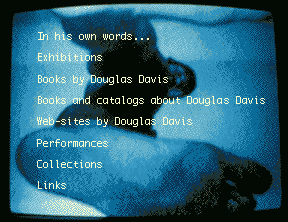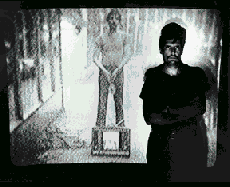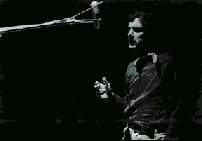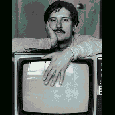 | |||
 | |||
 | ||||
 | ||||
Douglas Davis is an artist who specializes in making new media turn inside out--that is, do what it's not supposed to do (he makes video touch you, prints speak, the InterNet lie down in your lap like a puppy). He is also known as a pioneer in "long-distance art," most of all live satellite video and now streaming video theater on the Web. He gorges on advanced and traditional technology, including interactive websites, intercontinental performances linking "real" and "virtual" sources, high-density volumetric imagery, video-casting/installations, printmaking, drawing, and photography, as well as post-minimal "objects" and installations.. He has also used ancient, peeling paper, film, radio, and vintage stereopticons. With Joseph Beuys and Nam June Paik he created the first live global satellite broadcast of video performance art in 1977, for Documenta 6. Critic Donald Kuspit calls Davis "one of the more magnificent minds engaging modern art and modern media." His early work is defined and analyzed on his still-active website, The World's First Collaborative Sentence (1994), where elements from his exhibition, InterActions 1967-1981 is presented as background. They include critical essays by Susan Hoeltzel, Michael Govan, David Ross, and Nam June Paik. Commisioned by the Lehman College Art Gallery, the Sentence was given by its collectors, Barbara and Eugene M. Schwartz, to the Whitney Museum of American Art. In 1997, P.S.1/The Institute of Contemporary Art joined with several other museums to host MetaBody (The World's First Collaborative Visions of the Beautiful), commissioned by George Waterman III. In 1997, Davis launched Terrible Beauty, an evolving global multi-media theater piece. Its "chapters" have been performed before audiences in New York, Dublin, San Francisco, and Berlin. He has taught advanced media at more than 25 universities and art colleges and served as consultant in this field for several corporations & foundations. Davis' book, Art and the Future, published in several countries in 1973, is considered a classic in the field of art and technology. ArtCulture: Essays on the Post-Modern (1977), is a widely-quoted book of theoretical essays. The Museum Transformed (1991) is what Arthur C. Danto calls "a truly pioneering work" in the burgeoning genre of museum studies and theory. The Five Myths of TV Power (or, Why the Medium is Not the Message), 1993, focuses on the crucial importance of the viewer, the "human" element in media theory. Davis has been awarded grants for his work by the Rockefeller Foundation, the National Endowment for the Arts & the Trust for Mutual Understanding, among other institutions. He has testified often before Congress in behalf of artist's rights. In 1996, he co-founded with a group of artists and organizations a new collaborative devoted to the digital arts,"ThunderGulch," based in Lower Manhattan. | ||
Websites (Selected) --The World's First Collborative Sentence (commissioned by Lehman College Art Gallery; collection Whitney Museum of American Art, gift of Barbara and Eugene M. Schwartz): http://math240.lehman.cuny.edu/art --MetaBody (The World's First Collaborative Visions of the Beautiful). Commissioned by George Waterman III Collection; co-sponsored by P.S.1/The Institute of Contemporary Art, New York; Herbert F. Johnson Museum, Cornell, Ithaca; Municipal Art Gallery, Reykjavik, Iceland; Center for Contemporary Art, Warsaw, and others, 1997: http://this.is/METABODY --Terrible Beauty (an Evolving Work of Interactive Global Theater), 1997-2000, performed to date in New York, Dublin, San Francisco, and Berlin: http://here.is/TERRIBLEBEAUTY --http://www.this.is/DOUGLASDAVIS, 1997-to date, evolving. | ||||
LINKS Read various texts on Douglas Davis' Redness project: Go to the Terrible Beauty web-site: Read Douglas Davis' statement about MetaBody The world's first collaborative sentence: Learn how to join the sentence: Or go this way:
| |||||